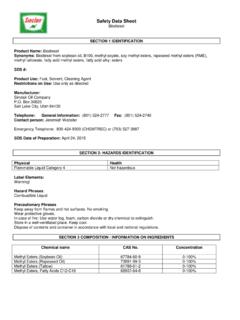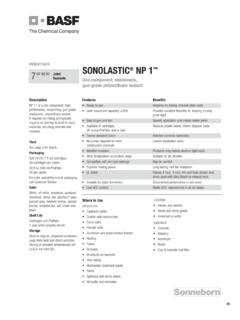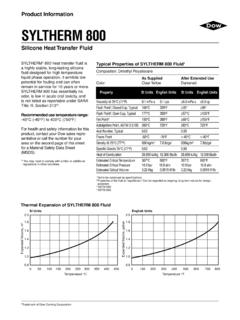Transcription of Safety Data Sheet Diesel Fuel - Sinclair Oil Corporation
1 Safety data Sheet Diesel fuel SECTION 1 IDENTIFICATION Product Name: Diesel fuel Synonyms: No. 2 Diesel fuel , Ultra Low Sulfur Diesel , Oil Distillate, Cycle Oil, fuel Oil Diesels Cycle Oil, Furnace Oil, Dyed fuel SDS #: F2 Product Use: Diesel fuel Restrictions on Use: Use only as directed Manufacturer: Sinclair Oil Company Box 30825 Salt Lake City, Utah 84130 Telephone: General Information: (801) 524-2777 Fax: (801) 524-2740 Contact person: Jeremiah Webster Emergency Telephone: 800-424-9300 (CHEMTREC) or (703) 527-3887 SDS Date of Preparation: January 23, 2015 SECTION 2: HAZARDS IDENTIFICATION Classification: Physical Health Flammable Liquid Category 3 Acute Toxicity Category 4 (Oral) Aspiration Toxicity Category 1 Skin Irritation Category 2 Specific Target Organ Toxicity Repeat Exposure Category 1 Carcinogen Category 2 Label Elements: Danger!
2 Hazard Phrases: Flammable liquid and vapor. Harmful if inhaled. May be fatal if swallowed and enters airways. Causes skin irritation. Suspected of causing cancer. Causes damage to thymus, liver and bone marrow through prolonged or repeated exposure. Diesel fuel January 23, 2015 Page 2 of 7 Precautionary Phrases: Prevention Obtain special instructions before use. Do not handle until all Safety precautions have been read and understood. Keep away from heat, sparks, open flames, and hot surfaces. No smoking. Keep container tightly closed. Ground and bond container and receiving equipment Use explosion-proof electrical, ventilating and lighting equipment. Use only non-sparking tools. Take precautionary measures against static discharge.
3 Do not breathe mist, vapors or spray. Wash thoroughly after handling. Use only outdoors or in a well-ventilated area. Wear protective gloves, eye protection. Response IF SWALLOWED: Immediately call a POISON CENTER or doctor. Do NOT induce vomiting. IF ON SKIN (or hair): Take off immediately all contaminated clothing. Rinse skin with water. If skin irritation occurs: Get medical attention. Take off contaminated clothing and wash it before reuse. IF INHALED: Remove person to fresh air and keep comfortable for breathing. Call a POISON CENTER or doctor. IF exposed or concerned: Get medical attention. In case of fire: Use water fog, foam, carbon dioxide, or dry chemical to extinguish. Storage and Disposal Store in a well-ventilated place. Keep cool.
4 Keep container tightly closed. Store locked up. Dispose of contents and container in accordance with local and national regulations. SECTION 3 COMPOSITION / INFORMATION ON INGREDIENTS Chemical name CAS No. Concentration Diesel fuel 68476-34-6 97-100% Naphthalene 91-20-3 0-3% SECTION 4 EMERGENCY and FIRST AID PROCEDURES Eye Contact: Immediately flush eyes with water for several minutes. Get medical attention if irritation persists. Skin Contact: Remove contaminated clothing and flush skin with water for several minutes. Wash thoroughly with soap and water. Get medical attention if irritation develops or persists. Launder clothing before reuse. Discard contaminated shoes. Inhalation: Remove to fresh air. If breathing is difficult have qualified personnel administer oxygen.
5 If breathing has stopped, administer artificial respiration. Get medical attention. Ingestion: Do not induce vomiting. Rinse mouth with water. Never give anything by mouth to an unconsciousness person. If vomiting occurs spontaneously, keep head below hips to prevent aspiration into the lungs. Get immediate medical attention. Diesel fuel January 23, 2015 Page 3 of 7 Most important symptoms/effects, acute and delayed: May cause eye irritation. Causes skin irritation with redness and drying. Inhalation may cause respiratory irritation and central nervous system effects. Harmful or fatal if swallowed. Aspiration during swallowing or vomiting may cause lung damage. May cause cancer based on animal data . Indication of immediate medical attention and special treatment, if necessary: Immediate medical attention is required for ingestion.
6 SECTION 5 FIRE and EXPLOSION HAZARD data Suitable extinguishing media: Use water fog, foam, carbon dioxide, or dry chemical. Do not use a steady stream of water. Product may float on the surface of water and create a floating fire hazard. Specific hazards arising from the chemical: This product is highly flammable and forms explosive mixtures with air. Vapors are heavier than air and will travel along surfaces to remote ignition sources and flash back. Closed containers may explode if exposed to extreme heat. Combustion may produce carbon oxides and other products of incomplete combustion. Special protective equipment and precautions for fire-fighters: Firefighters should wear full emergency equipment and a NIOSH approved positive pressure self-contained breathing apparatus.
7 Cool fire exposed container with water. Do not allow run-off from firefighting to enter drains or water courses. SECTION 6 ACCIDENTAL RELEASE MEASURES Personal precautions, protective equipment, and emergency procedures: Wear appropriate protective equipment. Eliminate ignitions sources and ventilate the area with explosion proof equipment. Wash thoroughly after handling. Environmental hazards: Avoid release into the environment. Report spill as required by local and federal regulations. Methods and materials for containment and cleaning up: Contain with an inert absorbent and place into a closable container for disposal. Use non-sparking tools and equipment. If spill has not ignited, use water spray to disperse the vapors and protect personnel attempting to stop leak.
8 Prevent entry in storm sewers and waterways. Runoff can cause a fire or explosion hazard in sewers. SECTION 7 HANDLING and STORAGE Precautions for safe handling: Avoid contact with eyes, skin and clothing. Avoid breathing vapors. Wash thoroughly after handling. Use only with adequate ventilation. Wash thoroughly with soap and water after handling. Keep containers closed when not in use. Keep product away from heat, sparks, flames and all other sources of ignition. Do not permit smoking in use or storage areas. Use with non-sparking tools and explosion proof equipment. Electrically bond and ground containers for transfer Do not cut, drill, grind or weld on or near containers, even empty containers. Empty containers retain product residues can be hazardous.
9 Follow all SDS precautions when handling empty containers. Conditions for safe storage, including any incompatibilities: S Store in accordance with regulations for the storage of flammable liquids. Store in a dry, well ventilated area away from heat, direct sunlight and all sources of ignition. Store away from oxidizers and other incompatible materials. Protect containers from physical damage. Diesel fuel January 23, 2015 Page 4 of 7 SECTION 8 EXPOSURE CONTROLS and PERSONAL PROTECTION Exposure Guidelines: INGREDIENTS EXPOSURE LIMITS Diesel fuel 100 mg/m3 TWA ACGIH TLV (inhalable fraction and vapor) Naphthalene 10 ppm TWA OSHA PEL 10 ppm, skin TWA ACGIH TLV Appropriate engineering controls: Use with local exhaust ventilation to maintain exposures below the occupational exposure limits.
10 Use explosion proof equipment where required Respiratory protection: If exposures are exceeded, use a NIOSH approved organic vapor respirator appropriate for the form and concentration of the contaminants should be used. Selection of respiratory protection depends on the contaminant type, form and concentration. Select in accordance with OSHA and good Industrial Hygiene practice. Skin protection: Impervious gloves such as nitrile rubber recommended to prevent skin contact. Eye protection: Wear chemical Safety goggles to avoid eye contact. Other: Impervious coveralls, apron and boots is required to prevent skin contact and contamination of personal clothing. A Safety shower and eye wash should be available in the immediate work area. SECTION 9 PHYSICAL and CHEMICAL PROPERTIES Appearance (physical state, color, etc.)







